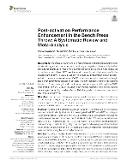Post-activation Performance Enhancement in the Bench Press Throw: A Systematic Review and Meta-Analysis

Datum vydání
2021Publikováno v
Frontiers in PhysiologyRočník / Číslo vydání
11 (January)ISBN / ISSN
ISSN: 1664-042XISBN / ISSN
eISSN: 1664-042XMetadata
Zobrazit celý záznamKolekce
Tato publikace má vydavatelskou verzi s DOI 10.3389/fphys.2020.598628
Abstrakt
Background: Mechanical power output is recognized as a critical characteristic of an athlete with regard to superior performance during a competition. It seems fully justified that ballistic exercises, in which the external load is projected into a flight phase, as in the bench press throw (BPT), are the most commonly prescribed exercises for the development of power output. In addition, the muscular phenomenon known as postactivation performance enhancement (PAPE), which is an acute improvement in strength and power performance as a result of recent voluntary contractile history, has become the focus of many strength and conditioning training programs. Although the PAPE phenomenon is widely used in the upper-body training regimens, there are still several issues regarding training variables that facilitate the greatest increase in power output and need to be resolved. Objective: The purposes of this meta-analysis were to determine the effect of performing a conditioning activity (CA) on subsequent BPT performances and the influence of different types of CA, intra-complex rest intervals, and intensities during the CA on the upper-body PAPE effect in resistance-trained men. Methods: A search of electronic databases (MEDLINE, PubMed, and SPORTDiscus) was conducted to identify all studies that investigated the PAPE in the BPT up to August 2020. Eleven articles, which met the inclusion criteria, were consequently included for quality assessment and data extraction. All studies included 174 resistance-trained men [age: 25.2 +- 2.1 years; weight: 88.4 +- 7.5 kg; height: 1.82 +- 0.03 m; bench press (BP) relative strength: 1.31 +- 0.14 kg +- kg-1] as participants. Meta-analyses of standardized mean effect size (ES) between pre-CA mean and post-CA mean from individual studies were conducted using the random-effects model. Results: The effect of PAPE in the BPT was small (ES = 0.33; p < 0.01). The BP exercise as a CA at an intensity of 60-84% one-repetition maximum (1RM) (ES = 0.43) induced slightly greater PAPE effect than a ballistic-plyometric (ES = 0.29) and a BP exercise at >=85% 1RM and at >100% 1RM as well as a concentric-only BP (ES = 0.23 and 0.22; ES = 0.11, respectively). A single set (ES = 0.37) of the CA resulted in a slightly greater effect than a multiple set (ES = 0.29). Moderate rest intervals induced a slightly greater PAPE effect for intensity below 85% 1RM (5-7 min, ES = 0.48) than shorter (0.15-4 min,Krzysztofik et al. Bench Press Throw Performance Enhancement ES = 0.4) and longer (>=8 min, ES = 0.36) intra-complex rest intervals. Considering an intensity above 85% 1RM during the CA, a moderate rest interval resulted in a similar PAPE effect (5-7 min, ES = 0.3) compared with longer (8 min, ES = 0.29) intra-complex rest interval, whereas shorter rest intervals resulted in a negative effect on BPT performance (0.15-4 min, ES = -0.13). Conclusion: The presented meta-analysis shows that performing a CA induces a small PAPE effect for the BPT performance in resistance-trained men. Individuals seeking to improve their BPT performance should consider preceding them with a single set of the BP exercise at moderate intensity (60-84% 1RM), performed 5-7 min before the explosive activity.
Klíčová slova
Post-activation, Performance Enhancement, Bench Press, Throw, Meta-Analysis
Trvalý odkaz
https://hdl.handle.net/20.500.14178/1627Licence
Licence pro užití plného textu výsledku: Creative Commons Uveďte původ-Nezpracovávejte 4.0 International







